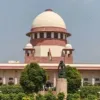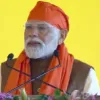'Guru Tegh Bahadur sacrificed his head to save dharma': PM Modi at Shaheedi Diwas event in Kurukshetra

"Standing on this very land of Kurukshetra, Lord Krishna declared the protection of truth and justice as the greatest religion... Guru Tegh Bahadur Ji also considered the protection of truth, justice, and faith as his religion. On this historic occasion, the Government of India has the privilege of dedicating a commemorative postage stamp and a special coin at the feet of Guru Tegh Bahadur Ji. I wish that our government continues to serve the Guru tradition in this manner.," he said.
Recalling atrocities during the Mughal era, PM Modi said Guru Tegh Bahadur displayed bravery and helped Kashmiri Hindus who were forcibly converted to Islam.
“Personalities like Sri Guru Tegh Bahadur Ji are rare in history. Their life, their sacrifice, and their character are a great source of inspiration. In that era of Mughal invaders, Guru Sahib established an ideal of bravery... During the era of Mughal invaders, Kashmiri Hindus were being forcibly converted to Islam. Amid this crisis, a group of victims sought assistance from Guru Sahib. At that time, Sri Guru Sahib had replied to those victims that you all should clearly tell Aurangzeb that if Sri Guru Tegh Bahadur accepts Islam, then we will all adopt Islam," he said.
PM Modi said Guru Tegh Bahadur never compromised on principles even during Aurangzeb rule and even dedicated his head in penance to protect religion.
"The cruel Aurangzeb ordered Guru Tegh Bahadur's imprisonment. However, Guru Tegh Bahadur himself announced his intention to go to Delhi. Mughal rulers even tempted him, but Guru Tegh Bahadur remained steadfast. He did not compromise on religion and principles. Therefore, to break his spirit and to divert Guru Sahib from the path, three of his companions, Bhai Dyala Ji, Bhai Sati Das Ji, and Bhai Mati Das Ji, were brutally murdered in front of him. But Guru Sahib remained steadfast. His resolve remained unwavering. He did not abandon the path of religion. In a state of penance, Guru Sahib dedicated his head to the protection of religion," he said.
Referring to Operation Sindoor, Prime Minister Narendra Modi said that the entire world saw that the new India neither fears nor bows down to terrorism.
PM Modi inaugurates Panchjanya memorial
PM Modi also inaugurated the newly built Panchjanya memorial, created in honour of Lord Krishna’s sacred conch, during his visit to the city, popularly known as the land of the Bhagavad Gita.
PM Modi toured the Mahabharata Anubhav Kendra, an immersive centre designed to present important moments from the Mahabharata through modern technology. The centre aims to showcase the epic’s cultural, historical and spiritual influence. Haryana Chief Minister Nayab Singh Saini accompanied him during the tour.
The Anubhav Kendra has been developed under the Government of India’s Swadesh Darshan scheme of the Ministry of Tourism. Built at an estimated cost of around Rs 200 crore, the complex uses digital installations to illustrate the narrative, philosophy and legacy of the Mahabharata.
A key feature within the complex is the Panchjanya memorial. The structure symbolises the triumph of truth and righteousness and is inspired by Krishna’s divine conch. The memorial stands nearly 4 to 5 metres high and weighs between 5 and 5.5 tonnes.
Modi raises saffron flag at Ram Temple in Ayodhya
Earlier in the day, PM Modi led a special ceremony in Ayodhya to signal the formal completion of the Ram temple. He hoisted a saffron-coloured flag atop the newly built shrine, marking a significant moment in the temple’s development.
PM Modi was joined at the event by RSS chief Mohan Bhagwat, Uttar Pradesh Governor Anandiben Patel and Chief Minister Yogi Adityanath. The ceremony took place in a traditional setting, drawing attention from people across the country.
The flag, shaped as a right-angled triangle and measuring 10 feet by 20 feet, carries several sacred symbols. It displays a bright Sun, the spiritual sign ‘Om’, and the Kovidara tree, all of which hold cultural and religious meaning.
Temple officials said the flag was raised during the ‘Abhijit Muhurat’, a time believed by Hindus to be highly auspicious. According to Champat Rai, general secretary of the Shri Ram Janmabhoomi Teerth Kshetra, this moment symbolises the official completion of the temple’s construction.
He added that the saffron colour stands for fire and the rising sun, reflecting ideals of sacrifice, purity, and devotion.
About The Author
Welcome to Aryan Age, an English newspaper that has been serving readers since 2011 from Delhi. With a loyal circulation of over 19,000, we are dedicated to providing our readers with the latest news and information, as well as insightful analysis and commentary that help them navigate the complex and rapidly changing world.







Comment List